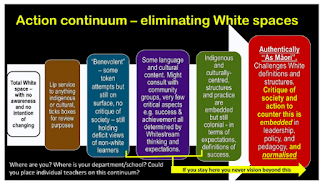Week 31 - Indigenous Knowledge & Cultural Responsiveness
I will use Rolfe's Reflection Model (2002).
Step One: What? What is your understanding of indigenous knowledge and cultural responsiveness and what are the two of the areas mentioned above that you want to focus on for discussion?
Indigenious Knowledge:
My understanding is that indigenous knowledge is like traditional knowledge. It is knowledge that has been passed down through generations and can have aconnection to the natural environment. It is often passed down through myths and legends, trough either a visual or oral retelling. The knowledge is regarded as sacred and interconnected - the word wisdom comes to mind.
Cultural Responsiveness:
My understanding is that being culturally responsive is a way to engage effectively and respectfully with individuals, families and communities. In a school context is is to understand the importance of enriching learning activites through validating and valuing the personal and cultural strengths of the students.
The two areas that I am going to focus on for reflection are Learning Activities and School-Wide Activities.
Step 2: So What? Evaluate your practice or your school practice in light of one of the following frameworks or use another one that you are familiar with.
I was fortunate to attend Ann Milne's ULearn 17 presentation. Watching it again has supported me to take a deeper understanding about culuturally sustaining practice therefore this is the framework I will use.
The first focus is on School-Wide Activities - I would place our school in the purple area transisitioning into green. Our school has made connections to our local Iwi through our Te Puna o Kemureti (Cambridge Community of Learners). We have recently visited our local marae to celebrate Matariki. For the majority of our students and families it was the first time they had had this opportunity. Our staff have attended a Te Reo 101 course held at the marae.
The second focus is Learning Activities and this is where I would place myself and the school within the blue transistioning to the purple area. This is an area that I can have a direct impact on through my own teaching practice.
Step 3: What Next? What might you or your school need to consider or take action on to move up to the next level of cultural responsiveness? What are the next steps?
For both of the two foci our next steps would be to ensure our students, families and communities voices are heard - to invite in and share indigenous knowledge, this can put the teacher in the position of the learner therefore stepping away from the power-base.
We need to ensure we continue on this journey and not put it into the 'too hard' basket.
For our school we need to ensure cultural responsiveness is an ongoing discussion in our planning and assessment along with continued PD as to what this is actually is and what it how it can be embedded in our school vision and values.
References
CORE Education.(2017, 17 October). Dr Ann Milne, Colouring in the white spaces: Reclaiming cultural identity in whitestream schools.[video file]. Retrieved from https://www.youtube.com/watch?v=5cTvi5qxqp4&feature=em-subs_digest

Comments
Post a Comment